马里奥博塔House at Riva San Vitale
圣维塔莱河住宅
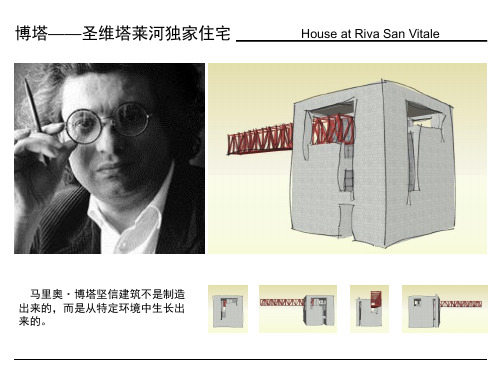
从主卧室看庭院
从书房平台看庭院
从餐厅看庭院
从庭院看起居室
砖是博塔所宠爱的素材,他用砖塑造出建筑外表的丰富质感. 博塔对细部构造一丝不苟
在界定限制的前提下,寻求与周围世界的 自由渗透。
建筑给予我们的是建构一个基地的机会, 而不仅仅是在一个基地上进行建构。
通过人为的手段来改变保持着某种平衡的 局面,以便创造新的平衡。
一层平面起居 通高 Nhomakorabea儿童卧室
比例之美:边长比:1.4:1:1.6
二层平面
主卧室 平台
三层平面
书房 四层平面
承重墙
主入口
非承重部分空心代 替,起到保温作用。
次入口
南
东、南两面向阳面湖,股有较大的开口。西面临坡,北面有冬季寒风,故开口较小。 封闭前提下,内部空间关系紧密又极富变化,各部分之间的变化十分丰富。 镂空和不规则的洞口,即引入了光线和环境,又使建筑本身与环境的对立达到平衡,这是对 路易斯·康“双层皮肤”更加灵活巧妙地应用。
这是博塔成名之作,从此以后博塔对住宅 设计进入了更深入的研究,并且陆续设计 了很多经典的住宅。
从这个建筑来看,博塔加深了对建筑原型 的探索,朴实敦厚的特点也像路易斯·康。
博塔的设计风格:总是在自然环境中先围 出一个封闭的盒体,然后再结合环境根据 需要在盒体上设计“洞口”。
Mario botta
1943 出生于瑞士提契诺州门德里西奥 1958 在卡门里希事务所研修制图 1969 毕业于威尼斯大学建筑系 1970 在卢加诺与人合伙开业 1971 设计著名的圣维塔尔河住宅,一举成名 1976 被聘为洛桑州立工科大学客座教授
博塔的建筑要素
古典的对称平面布局 简洁的几何体形 封闭而厚实的墙 用于采光和选景的狭缝空间 三个自由组织的层面 置于中轴线上的垂直交通 顶部的天窗
马里奥.博塔圣-维塔尔私人住宅

寻求与周围世界的自 由渗透 ► 建筑给予我们的是建 构一个基地的机会, 而不仅仅是在一个基 地上进行建构 ► 通过人为的手段来改 变保持着某种平衡的 局面,以便创造新的 平衡
► 家是心灵的庇护所。应该是神秘的,是令人
神往的。 ► 封闭前提下,内部空间关系紧密又极富变化, 各部分之间的对话十分丰富。 ► 镂空和不规则的开窗,既引入了光线和环境, 又使本身与环境的对立达到平衡。这是对康 “双层皮肤”的更加灵活巧妙的运用。
►
他曾经是卡洛尼的学生,后又赴威尼斯学习 意大利新理性主义,并通过和斯卡巴的接近, 获得了一种丰富而精巧的空间造型本领.他还 有幸在柯布西耶和路易斯.康手下工作过,学 习了柯布的立体主义和康的建筑原型的思想, 这些经历对他以后的实践颇有影响.
Botta的住宅设计要素
►强烈的几何形体
►对称布局
►封闭的墙
►凉廊
►壁炉
►天窗
►镂空 ►砖石立面
卢加诺湖 雪山
圣维塔尔住宅
去掉遮盖
提取体块
功能体块
机动空间
楼梯间设计巧妙,将 转角处与走廊结合起 来,节约了空间,又 在两个主要使用空间 之间形成通路。
主要使用空间
水平布局
承重墙 非承重部分空心代 替,且起到保温作 用
结构分析
主入口
次入口
垂直交通分析
希望我们都能从建模中得到提高
谢谢!OVER
书房 平台 平台 儿童卧室 餐厅、厨房 主卧室 起居室
功能分布
立面图
东、南立面
西、北立面
立面-开窗-采光
书房 平台 平台 儿童卧室 餐厅、厨房 庭院 主卧室 起居室
四层平面
三层平面
二层平面
一层平面
马里奥博塔

马里奥·博塔生平简介1943年出生于瑞士的提契诺州门德里西奥(MENDRISIO),年轻时曾边学习边从事实际设计活动。
1965年在勒·柯布西耶的工作室参加威尼斯市立养老院的设计。
1969年毕业于威尼斯大学建筑学院。
毕业时,与主考官卡罗·斯卡帕相遇。
※马里奥·博塔幸运的受到三位建筑巨匠的熏陶,据说,其中以对光的利用颇为精通的路易斯·康对他的影响最大。
与路易斯·康相遇,合作设计了威尼斯新会议厅工程中的展览会。
1970年博塔在瑞士卢加诺开设了自己的建筑事务所。
※1970年以来,在洛桑联邦工业大学以及欧洲、美国、拉丁美洲等多所大学从事授课、开设研讨班等教学活动,并在各地举办个人作品展览。
1976年被瑞士洛桑联邦工业大学聘请为客座教授,1988年应邀担任美国耶鲁大学建筑学院的客座教授。
1996年瑞士意大利大学孟德里索新建筑学院院长设计风格在结束跟随路易斯·康的学习之后,他逐渐开始形成自己的风格。
博塔深入研究了众多建筑风格,诸如:多立斯风格、爱奥尼亚风格以及科林斯风格等古老的建筑风格,他开始从这些历史风格中得出相应的色彩、材质、原料以及结构等方面的构思,其所有的工作都逐渐从后现代的古朴风格中得出其内在的联系。
博塔将各种对立的因素联系起来,因此,他所设计的建筑就呈现了极为独特的特征。
博塔对环境有极强的洞察力,因此他的建筑作品常常根据不同的环境条件而展现不同的优势。
他说道:“每一项建筑作品都有它相对应的环境,在设计建筑时,其关键是考虑建筑所辖的领地”。
1980年,他增加了这样的观点:“我认为当今建筑的精华来源于比较的程度:它只承认人为因素和自然环境之间的平衡,而这样的因素又来自当地生境。
”作为提契诺学派的主要代表,其作品根植于意大利理性主义和欧洲现代主义,将欧洲严谨的手工艺传统、历史文化的底蕴、提契诺的地域特征与时代精神完美地表现在建筑上。
40多年来,博塔已设计项目600多项,涵盖了私人住宅、教堂、办公、银行、博物馆、学校等建筑类型。
解析马里奥.博塔

解析马里奥.博塔在位于瑞士的南部的提契诺(Ticino),半个多世纪以来,建筑师们一直尝试将历史传统和现代建筑完美的结合起来,继承和发展自己的地域特色,并以优异的作品形成了提契诺现象,是提契诺的建筑文化在国际上享有无可非议的声望及认可。
在现代的建筑实践中,形成提契诺现象的代表人物是马里奥·博塔。
理性与经验的契合博塔的建筑思想显然受到了理性主义的影响,大多作品既折射出古典理性主义的特征,又打上了新理性主义的烙印。
在方法上,以古典集合型及其组合作为形式构成的主要元素,讲究主从关系,轴线关系,对称关系比例关系等;在立面上,构图中心极强,并且以几何形天窗统帅全局;在构图上,博塔钟爱几何原型,特别是圆形,强调建筑的纪念性;在建筑语汇上,应用古典建筑建筑的语言:建筑边角的保守,中央的空壁,倾斜而稀少,准确定位的窗洞,类似古典建筑的拱门等等:在材料的使用上,发挥材料的质感和表现力:在建筑构造和细部上,以砖和石构成了简洁,完整,精美的图案。
博采众长,兼容并蓄博塔有着不同凡响的经历。
他从师卡洛·斯卡帕,又有幸在勒·柯布西耶,路易斯·康手下工作。
他研究阿尔多·罗西的新理性主义,邂逅詹姆斯·斯特林并与之交流。
他批判地吸收各种建筑文化和思潮,博采众长,兼容并蓄,结合提契诺的地域特色,创作出令人瞩目的作品。
1965年夏,博塔到勒·柯布西耶在威尼斯建造的展览室工作。
勒·柯布西耶对图形的超凡直觉,对古老城市的洞察和想现代建筑艺术的演化,对威尼斯问题的敏锐注视和精辟分析都给博塔留下了不可磨灭的印象。
此后在博塔的建筑作品中不时折射出勒·柯布西耶的影子。
1969年,在威尼斯会议中心的设计中,博塔与路易斯·康共同工作了三周。
路易斯·康的浪漫主义和诗一样的建筑队博塔产生了重大的影响。
博塔的建筑作品具有很强的封闭感,强调建筑与外界的界定,在重复基本几何和自然光运用等设计手法上皆隐含着来自路易斯·康的文化继承。
小学上册第十三次英语第一单元测验卷
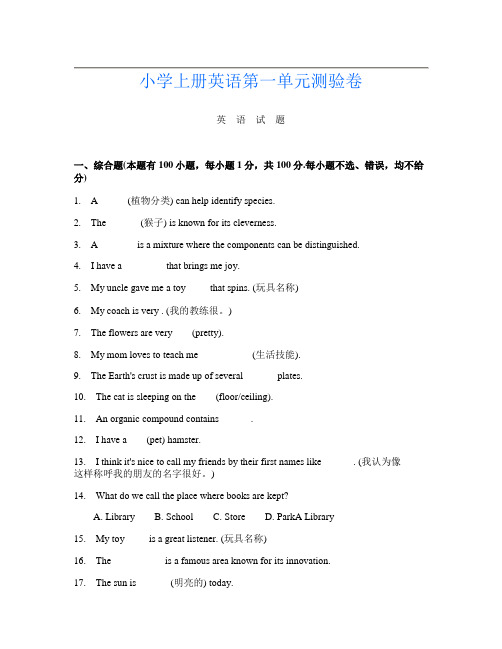
小学上册英语第一单元测验卷英语试题一、综合题(本题有100小题,每小题1分,共100分.每小题不选、错误,均不给分)1. A _____ (植物分类) can help identify species.2.The ______ (猴子) is known for its cleverness.3. A _______ is a mixture where the components can be distinguished.4.I have a ________ that brings me joy.5.My uncle gave me a toy ____ that spins. (玩具名称)6.My coach is very . (我的教练很。
)7.The flowers are very ___ (pretty).8.My mom loves to teach me __________ (生活技能).9.The Earth's crust is made up of several ______ plates.10.The cat is sleeping on the ___ (floor/ceiling).11.An organic compound contains ______.12.I have a ___ (pet) hamster.13.I think it's nice to call my friends by their first names like ______. (我认为像____这样称呼我的朋友的名字很好。
)14.What do we call the place where books are kept?A. LibraryB. SchoolC. StoreD. ParkA Library15.My toy ____ is a great listener. (玩具名称)16.The __________ is a famous area known for its innovation.17.The sun is ______ (明亮的) today.18.The storm made the trees ___ (shake).19.The crow is often seen as a ______ (聪明的) bird.20.What do we call the sport of jumping over a bar?A. High JumpB. Long JumpC. Pole VaultD. Triple JumpA21.What is the name of the famous clock tower in London?A. Big BenB. Eiffel TowerC. Tower of PisaD. Willis Tower22.The park is _______ for everyone to enjoy.23.The ______ helps us learn about sustainability.24. A _____ (环境) can change how plants grow.25.I share my secrets with my __________. (最好的朋友)26.What do you call a person who writes plays?A. PlaywrightB. AuthorC. ScreenwriterD. NovelistA27.What is the name of the fairy tale character who lived in a shoe?A. JackB. JillC. Old Mother HubbardD. Old Woman Who Lived in a ShoeD28.What is the largest planet in our Solar System?A. SaturnB. JupiterC. EarthD. Mars29.The goldfish is one of the most popular ______ (宠物) in homes.30.The fish swims in the _________. (水)31.My friend is a ______. He enjoys gardening.32.What is 15 divided by 3?A. 4B. 5C. 6D. 7B33.What is the name of the longest river in the world?A. NileB. AmazonC. MississippiD. Yangtze34.The __________ is a famous city known for its flowers. (阿姆斯特丹)35.We have a ______ (精彩的) event planned for next month.36.What do we call the imaginary line that divides the Earth into the Northern and Southern Hemispheres?A. EquatorB. Prime MeridianC. Tropic of CancerD. Tropic of CapricornA37.The first man on the moon was _______ Armstrong.38.I love to explore new _______ (地方). Each place has its own _______ (特色).39.The main source of energy for the Earth is ______.40.She _____ (cooks/cleans) dinner every night.41.We celebrate my birthday with a ________ (蛋糕) and balloons. I invite my________ (朋友) over.42.An unstable nucleus can undergo _____ (radioactive decay).43.The ______ grows in forests.44.The ______ is known for its elaborate courtship dance.45.Who is known for discovering gravity?A. EinsteinB. NewtonC. GalileoD. TeslaB46.What is the largest mammal in the world?A. ElephantB. Blue WhaleC. GiraffeD. HippoB47.What is the term for a piece of furniture used for sitting?A. TableB. ChairC. SofaD. BenchB48. A reaction that absorbs heat is ______.49. A _______ (小大雁) migrates south for the winter.50.My sister enjoys making ____ (videos) for fun.51.What do you call the measurement of how hot or cold something is?A. TemperatureB. WeatherC. ClimateD. AtmosphereA52.The raccoon washes its food in _________. (水)53.I have a special ________ that brings me joy.54.What type of animal is a parrot?A. MammalB. ReptileC. BirdD. FishC55.What do you call a baby dog?A. KittenB. CubC. PupD. CalfC56.I call my grandfather _____ (爷爷).57.I play _____ (游戏) on my tablet.58.The _____ (rainbow) is beautiful.59. A chemical that resists changes in pH is a ______.60.The chemical formula for potassium nitrate is _____.61.Canal connects the Mediterranean Sea to the __________ (红海). The Suez62. A _______ can be used to measure the pressure of liquids in different environments.63. A __________ is a region characterized by specific features.64.What do we call the opposite of ‘happy’?A. SadB. GladC. JoyfulD. Cheerful65.The fish is _____ in the tank. (swimming)66.My favorite book is about ______ (魔法).67.The ______ shares interesting facts about nature.68.The _____ (nectar) attracts pollinators.69.What is the capital of the Netherlands?A. AmsterdamB. RotterdamC. HagueD. UtrechtA70.Which fruit is red and often mistaken for a vegetable?A. BananaB. TomatoC. CarrotD. Grape71.What is the capital of Seychelles?A. VictoriaB. MahéC. PraslinD. La DigueA72.The badger digs a ______.73.How many sides does a hexagon have?A. FiveB. SixC. SevenD. Eight74.What is 10 + 5?A. 12B. 14C. 15D. 16C75.The chemical symbol for copper is _____.76.The capital city of Angola is __________.77.What do you call the process of making a copy of a document?A. PrintingB. ScanningC. DuplicatingD. CopyingD78. A process that separates mixtures using a filter is called ______.79.I can see a ______ in the sky. (bird)80.What is the capital of Grenada?A. St. George'sB. GouyaveC. GrenvilleD. CarriacouA81.I enjoy _____ (参加) workshops.82.The first person to circumnavigate the globe was ______ (麦哲伦).83.How many colors are in the rainbow?A. 5B. 6C. 7D. 884. A ______ reaction releases energy, often as heat or light.85. A _____ (cactus) is well-adapted to dry conditions.86.The ______ (小鳄鱼) is resting in the sun.87. A ______ is a geographical area defined by its unique characteristics.88.We should _______ (保持) our environment clean.89.The process of burning is called ______.90.What do we call the process of taking care of plants?A. GardeningB. CookingC. DrawingD. WritingA91.The story is very ________.92.This boy, ______ (这个男孩), is working on a science project.93.Acids turn blue litmus paper ______.94.The ______ is an organ that helps us see.95.We have a ______ (丰富的) range of activities at school.96.Which of these is a fruit?A. CarrotB. PotatoC. AppleD. LettuceC97.My favorite ice cream flavor is ______ (巧克力).98.The chemical symbol for neodymium is _______.99.What is the opposite of "noon"?A. MorningB. AfternoonC. MidnightD. DuskC 100.The _____ (ocean/lake) is calm.。
各大联赛球队主场名称

克罗托内
埃济奥·希达球场(Ezio Scida)
克罗托内
佩斯卡拉
亚德里亚海球场(Adriatico)
佩斯卡拉
萨勒尼塔纳
阿勒切球场(Arechi)
萨勒尼塔纳
科莫
西尼加格利亚球场(Giuseppe Sinigaglia)
科莫
特拉纳
利伯纳蒂球场(Libero Liberati)
特拉纳
威尼斯
彭佐球场(Pierluigi Penzo)
索里亚
帕尔玛
塔尔迪尼球场(Ennio Tardini)
帕尔马
那不勒斯
圣保罗球场(San Paolo)
那不勒斯
锡耶纳
弗朗基球场(Artemio Franchi)
锡耶纳
佛罗伦萨
弗朗基球场(Artemio Franchi)
佛罗伦萨
亚特兰大
阿祖里球场(Atleti Azzuri d'Italia)
贝加莫
热那亚
路易吉·费拉里斯球场(Luigi Ferraris)
米德尔斯堡
朴茨茅斯
弗兰顿球场(FrattonPark)
朴茨茅斯
热刺
白鹿巷球场(WhiteHart Lane)
伦敦
布莱克本
伊伍德公园球场(EwoodPark)
布莱克本
曼城
城市体育场(TheCity of Manchester)
曼彻斯特
埃弗顿
古迪逊公园球场(GoodisonPark)
利物浦
伯明翰
圣安德鲁球场(St.Andrews)
德尔·弗伦德斯萨夫特球场(Stadion der Freundschaft)
科特布斯
法兰克福
马里奥-博塔

•
事实上,共27,000立 方米的室内空间,除天窗、 首层建筑的花岗岩外墙和 建筑一侧的几个玻璃窗外 露以外,其它部分全部嵌 入山体当中。马里奥·博 塔(Mario Botta)称这个 设计理念为“精华”。 • 共四层的完全按照山 体本身的倾斜度来设计, 并且将主体部分植入植被 与白雪之下。钢架玻璃结 构的“发光树”部分高低 不平地分布在山体的树木 之间,同时为温泉内部提 供最佳的户外景观。同时, 这些玻璃窗也经过特别设 计,外立面融雪,内立面 除雾,以确保从室内能够 清晰观赏到室外的自然美 景。
目录
1、马里奥·博塔个人生平简介 2、马里奥·博塔的建筑理念
3、马里奥·博塔建筑作品分析
名片:
1943年,马里奥· 博塔出生在瑞士门德里西奥。 博塔中学辍学,15岁起就从事建筑设计工作,后在卢加诺 跟随Cnenisch和Carloni进行建筑设计等方面的学习. 1964 年,他通过了艺术学院的入学考试,当年秋,他开 始在威尼斯大学建筑学院学习。 1969年,他遇到了几位在建筑 行业有重大影响的著名设计师。 1970年,博塔在卢加诺开设了 自己的建筑事务所;1976年被瑞 士桑联邦工业大学聘请为客座教 授;1988年应邀担任美国耶鲁大 学建筑学院的客座教授。
15.1993 瑞士巴塞尔博物馆(Museum Jean Tinguely Basel) 16.1993 卢加诺(Caimato Building Lugano) 17.1994 旧金山现代艺术博物馆(SF Museum of Modern Art) 18.1995 瑞士巴塞尔 UBS 大楼(UBS building Basel) 19.1995 意大利米兰 Sartirana 教堂(Church of Sartirana Milano,Italy) 20.1996 蒙特住宅区(Resident Housing Monte Carasso) 21.1997 巴伐利亚(Benkert K igsberg Bavaria) 22.1998 以色列港市特拉维夫Cymbalista住宅区(Cymbalista Synagogue Tel Aviv) 23.2000 意大利 Pieve 科学院(Scientific College Pieve,Italy)
圣维塔莱河住宅[文字可编辑]
![圣维塔莱河住宅[文字可编辑]](https://img.taocdn.com/s3/m/4da12b4cf705cc1754270926.png)
House at Riva San Vitale
马里奥·博塔坚信建筑不是制造 出来的,而是从特定环境中生长出 来的。
圣维塔莱河住宅
卢加诺湖
雪山
圣维塔莱河独家住宅,这个小住宅位于卢加诺湖畔的坡地上,是一座不加装饰的 混凝土塔楼,看上去像一座封闭的堡垒,与其说它与环境景观相协调,不如说是与之 相对抗,它本身就是环境景观的创造者;而联系室内外的高架铁桥,与其说是与周围 环境相联系,还不如说是加剧了与自然的对抗与隔绝。正是以这种方式,博塔表达了 他的“建构场地”的思想。
马里奥·博塔采用圆柱体的目的是想避开与周围 杂乱无章的一切建筑的对比,同时,设法在空间 上与远处的风景和地平线取得联系。马里奥·博 塔创造出了一种不同以往的环境条件,圆房子所 表现出来的独立性与周围环境产生了强烈的对比。 周边乡村景色则通过入口门廊引入室内,内外融 合在一起,人们所处的环境则向外不断延伸。这 种创造环境的意图是马里奥·博塔理解环境的真 实表现。
从主卧室看庭院
从书房平台看庭院
从餐厅看庭院
从庭院看起居室
砖是博塔所宠爱的素材 ,他用砖塑造出建筑外表的丰富质感 . 博塔对细部构造一丝不苟
在界定限制的前提下,寻求与周围世界的 自由渗透。
建筑给予我们的是建构一个基地的机会, 而不仅仅是在一个基地上进行建构。
通过人为的手段来改变保持着某种平衡的 局面,以便创造新的平衡。
Mario botta
马里奥·博塔惯用的三大建筑语汇:几何 线条、中心对称、自然采光。
几何线条——作为博塔建筑特征的线条,构成
鲜明的外轮廓和唯美的建筑风格,具有让 人们记住该建筑的效果:作品中频频出现 的窄缝,被认为是源自水滴的几何学设计。
《建筑采光》PPT课件
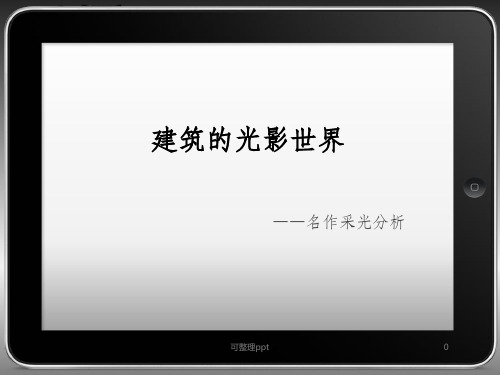
16
赫尔佐格和德梅隆——现代之光
建筑师赫尔佐格和德梅隆是一对很独特的组合。 和绝大部分的现代主义建筑师不同,他们的设计并 不是从建筑的形状和外观出发,而是从建造的过程 和材料出发,思考有什么搭配的机会。
赫尔佐格与德梅隆关于其建筑中的"装饰性"细部的观念可以表述为: 人们无法在不影响整体感觉的状态下减少它们。他们建筑理想的重要方 式其实是那些最为奇异的表现,包括印在玻璃上的植物图案:"表皮是内外 之间的隔膜,因此'装饰'的概念可以涵盖几何、斑纹、反射与透明……在 这种情况下,表皮成为人工与自然之间的一个过滤器。"
可整理ppt
11
悬挑的顶篷被窄长的采光缝——“光的缝隙”切割成互不相连的巨 大板块;从缝隙中倾泻而下的自然光线游走于各个小空间之间,把整 个建筑连结成一个流动的大空间。
可整理ppt@
12
圣而顶璃
的静部窗休 感谧进以息 觉,入外厅 。从,,具
而使自有 创室然较 造内光大 出气线的 一氛主落 种幽要地 神暗从玻
在中庭内,设计师把 它作为一个城市的要素来 处理,交通系统与中庭空 间紧密联系。
可整理ppt
8
围进作斜斜 有入用的角在 序大为透切顶 地楼采明割部 通宽集平,, 往敞自面把图 各的然内顶腾 个中光,棚形 展心,该暴状 厅,使平露的 的中光面在图 路心能主一形 线周够要个被
。
可整理ppt
9
彼得 卒姆托——静谧之光
可整理ppt@
14
奥地利布雷根茨美术馆
该馆在形体上是一个从底部到 顶部都覆盖以完全相同的半透明玻 璃板的正方体。整个建筑如同水晶 般纯净地矗立在康斯坦捷湖畔,正 如建筑师所期望的“将清晰透射光 线的薄雾吸纳进建筑”。
圣维塔莱河住宅
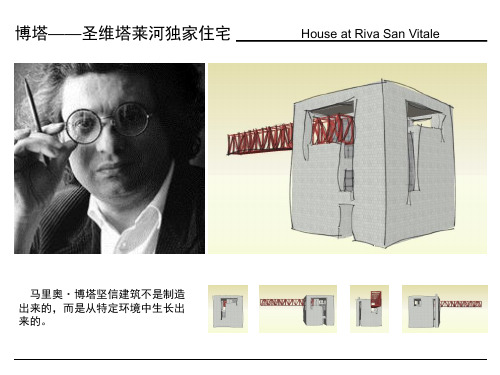
莫比奥·苏比利欧独家住宅
关于空间
马里奥·博塔的建筑关键词
Architectural Key Words
在博塔看来,建筑必须容许多样的使
用方式,而不可强制规定居住方式,卓 越的建筑仅能固定在某些原则之下,并 且住户可以依自己的意愿自由地使用。 博塔反对那些限定行动及居住方式的建 筑。博塔认为,建筑师对人们的生活空 间,只不过附加了一部的条件,此外都 要靠居住者自己来发展。因此,博塔的 住宅作品,在空间结构或平面类型上, 经常反复采用一定的原则。
与其他地域主义者不同的是,博 塔认为,建筑与场地的呼应并不 是简单的融于自然环境之中,而 应当是对自然的反抗和控制,他 的地域主义思想体现出一种冲突 与平衡的批判性思想,他认为建 筑设计是场所的设计,是改变原 有环境、创造新环境的活动,新 建筑是新的转变过程的基点,正 如他所指出:“建筑给予我们的 是建构场地的机会,而不仅仅是 在场地上进行建构。”相对于西 扎、普雷多克通过具体的建筑形 态再现场所精神,博塔显然没有 以有机形式去回应场地,而是通 过方、圆这些纯粹的几何形式作 为建筑基本要素,去创造一个与 自然隔绝的世界。
博塔——圣维塔莱河独家住宅
House at Riv坚信建筑不是制造 出来的,而是从特定环境中生长出 来的。
圣维塔莱河住宅
卢加诺湖
雪山
圣维塔莱河独家住宅,这个小住宅位于卢加诺湖畔的坡地上,是一座不加装饰的 混凝土塔楼,看上去像一座封闭的堡垒,与其说它与环境景观相协调,不如说是与之 相对抗,它本身就是环境景观的创造者;而联系室内外的高架铁桥,与其说是与周围 环境相联系,还不如说是加剧了与自然的对抗与隔绝。正是以这种方式,博塔表达了 他的“建构场地”的思想。
2024THUSSAT中学生标准学术能力诊断性测试英语试题及答案
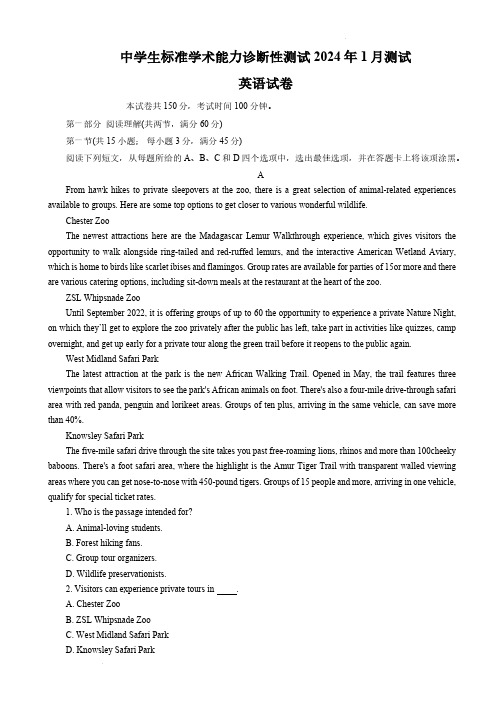
中学生标准学术能力诊断性测试2024年1月测试英语试卷本试卷共 150分,考试时间100 分钟。
第一部分阅读理解(共两节,满分 60分)第一节(共15 小题;每小题3分,满分 45分)阅读下列短文,从每题所给的A、B、C和D四个选项中,选出最佳选项,并在答题卡上将该项涂黑。
AFrom hawk hikes to private sleepovers at the zoo, there is a great selection of animal-related experiences available to groups. Here are some top options to get closer to various wonderful wildlife.Chester ZooThe newest attractions here are the Madagascar Lemur Walkthrough experience, which gives visitors the opportunity to walk alongside ring-tailed and red-ruffed lemurs, and the interactive American Wetland Aviary, which is home to birds like scarlet ibises and flamingos. Group rates are available for parties of 15or more and there are various catering options, including sit-down meals at the restaurant at the heart of the zoo.ZSL Whipsnade ZooUntil September 2022, it is offering groups of up to 60 the opportunity to experience a private Nature Night, on which they’ll get to explore the zoo privately after the public has left, take part in activities like quizzes, camp overnight, and get up early for a private tour along the green trail before it reopens to the public again.West Midland Safari ParkThe latest attraction at the park is the new African Walking Trail. Opened in May, the trail features three viewpoints that allow visitors to see the park's African animals on foot. There's also a four-mile drive-through safari area with red panda, penguin and lorikeet areas. Groups of ten plus, arriving in the same vehicle, can save more than 40%.Knowsley Safari ParkThe five-mile safari drive through the site takes you past free-roaming lions, rhinos and more than 100cheeky baboons. There's a foot safari area, where the highlight is the Amur Tiger Trail with transparent walled viewing areas where you can get nose-to-nose with 450-pound tigers. Groups of 15 people and more, arriving in one vehicle, qualify for special ticket rates.1. Who is the passage intended for?A. Animal-loving students.B. Forest hiking fans.C. Group tour organizers.D. Wildlife preservationists.2. Visitors can experience private tours in .A. Chester ZooB. ZSL Whipsnade ZooC. West Midland Safari ParkD. Knowsley Safari Park3. From the passage, we know that .A. delicious meals are offered to tourists in the four parksB. private tours are available in the four parksC. all the parks can provide driving-through servicesD. visitors can have access to walking trails in the four parksBScientists regularly make vital new discoveries, but few can claim to have invented an entirely new field of science. Chemist Carolyn Bertozzi is one of them. Her discovery of biorthogonal chemistry(生物正交化学) in 2003 created a brand-new discipline of scientific investigation, which has enabled countless advances in medical science and led to a far greater understanding of biology at a molecular(分子的) level. On October 5, Bertozzi was awarded the Nobel Prize in Chemistry, jointly with two other professors. She is also the only woman to be awarded a Nobel Prize in science this year, after an all-male line-up in 2021.Bertozzi was the middle daughter of an MIT physics professor and a secretary. Few predicted that Bertozzi would be the most famous person in the family. While her academic performance was not bad in high school, she was fond of playing soccer. She end ed up being admitted to Harvard University. Despite her talent in soccer, she found it too time-consuming and quit the sport to devote herself to academics.But before becoming a rock star scientist, Bertozzi almost became an actual rock star. When she started at Harvard, she was tempted to major in music. That idea was “unpopular” with her parents, and she was timid about defying them. Instead, she chose the premed (医学预科的) track that included classes in math and sciences, and declared herself a biology major at the end of her first year of college.Her interest in music did not completely fall by the wayside, however. Bertozzi played keyboards and sang backup vocals for a hair metal band. Bertozzi, however, did not play with the band for long. Once the band's practices and performances conflicted with her labs and classes, there was only one outcome.Plus, she’d soon have organic chemistry to think about a course which is infamous for weeding out pre-meds. Without any clear career ambitions up to that point, Bertozzi had been thinking about possibly becoming a doctor when, in her sophomore year(大二学年), she suddenly fell so head over heels in love with her chemistry course that she couldn't tear herself away from her textbooks long enough to go out onSaturday nights. A torture to many was pure pleasure for her. Bertozzi changed her major from bi ology to chemistry a year later.Bertozzi has sometimes joked about her having missed out on her chance to follow Morello to LosAngeles. “I didn't get on that bus, and my playing is now limited to ‘The Wheel s on the Bus Go Round,’ I'm waiting for my sons to get old enough to appreciate 1980s heavy metal!”4. Which of the following statements is TRUE according to the passage?A. Bertozzi is one of those scientists who made significant new discoveries.B. Bertozzi was the only female to win a Nobel Prize in science in 2021.C. Bertozzi played keyboards and sang backup vocals throughout her college years.D. Bertozzi initially planned to become a doctor.5. The underlined word in Para 3 means .A. tellB. disobeyC. approachD. threaten6. The organic chemistry course Bertozzi took was known to be .A. easy and enjoyableB. difficult to pass for pre-med studentsC. popular among hair metal band playersD. a required course for all college students7. What kind of person do you think Carolyn Bertozzi is?A. Brave and sympathetic.B. Athletic and critical.C. Humble and passionate.D. Talented and creative.CWillie Sutton, a once celebrated American criminal, was partly famous for saying he robbed banks because “that’s where the money is.” Actually, museums are where the money is. In a single gallery there can be paintings worth more, taken together, than a whole fleet of jets. And while banks can hide their money in basements, museums have to put their valuables in plain sight.Nothing could be worse than the thought of a painting as important as The Scream, Edvard Munch's impressive image of a man screaming against the backdrop of a blood-red sky, disappearing into a criminal underworld that doesn't care much about careful treatment of art works. Art theft is a vast problem around the world. As many as 10,000 precious items of all kinds disappear each year. And for smaller museums in particular, it may not be a problem they can afford to solve. The money for insurance on very famous pictures would be budget destroyers even for the largest museums.Although large museums have had their share of embarrassing robberies, the greatest problem is small institutions. Neither can afford heavy security. Large museums attach alarms to their most valuable paintings, but a modest alarm system can cost $500,000 or more. Some museums are looking into tracking equipment that would allow them to follow stolen items once they leave the museums. But conservators are concerned that if they have to insert something, it might damage the object. Meanwhile, smaller museums can barely afford enough guards, relying instead on elderly staff.Thieves sometimes try using artworks as money for other underworld deals. The planners of the 2006robbery of Russborough House near Dublin, who stole 18 paintings, tried in vain to trade them for Irish Republican Army members held in British prison. Others demand a ransom(赎金) from the museum that owns the pictures. Once thieves in Frankfurt, Germany, made off with two major works by J. M. W. Turner from the Tate Gallery in London. The paintings, worth more than $80 million, were recovered in 2012 after the Tate paid more than $5 million to people having “information” about the paintings. Though ransom is illegal in Britain, money for looking into a case is not, provided that police agree the source of the information is unconnected to the crime. All the same, where information money end s and ransom begins is often a gray area.8. Why do smaller museums face a greater challenge in preventing art theft?A. They lack experienced staff.B. They cannot afford high-tech security systems.C. They do not have valuable artworks.D. They lack interest in art conservation.9. What is the concern of conservators regarding the use of tracking equipment to prevent art theft?A. It might damage the artwork.B. It is too expensive for smaller museums.C. It is difficult to insert into the paintings.D. It is ineffective for valuable paintings.10. From Paragraph 4, we can learn that .A. the thieves demanded a ransom from the Tate GalleryB. the Tate Gallery regained the lost paintings illegallyC. the money paid was considered an information fee, not a ransomD. the police requested the Tate Gallery to pay the money11. The purpose of this passage is .A. to remind criminals to protect and preserve the paintingB. to give suggestions on how to avoid the crimes of art theftC. to urge museums to set up more advanced security systemsD. to make people aware of art theft and the necessity of good security systemsDWho cares if people think wrongly that the Internet has had more important influences than the washing machine? Why does it matter that people are more impressed by the most recent changes?It would not matter if these misjudgments were just a matter of people's opinions. However, they have real impacts, as they result in misguided use of scarce resources.The fascination with the ICT(Information and Communication Technology) revolution, represented by the Internet, has made some rich countries wrongly conclude that making things is so “yesterday” that they should try to live on ideas. This belief in “post-industrial society” has led those countries to neglect their manufacturing sector(制造业) with negative consequences for their economies.Even more worryingly, the fascination with the Internet by people in rich countries has moved the international community to worry about the “digital divide” between the rich countries and the poor countries. This has led companies and individuals to donate money to developing countries to buy computer equipment and Internet facilities. The question, however, is whether this is what the developing countries need the most. Perhaps giving money for those less fashionable things such as digging wells, extending electricity networks and making more affordable washing machines would have improved people's lives more than giving every child a laptop computer or setting up Internet centres in rural villages, I am not saying that those things are necessarily more important, but many donators have rushed into fancy programmes without carefully assessing the relative long-term costs and benefits of alternative uses of their money.In yet another example, a fascination with the new has led people to believe that the recent changes in the technologies of communications and transportation are so revolutionary that now we live in a “borderless world”. As a result, in the last twenty years or so, many people have come to believe that whatever change is happening today is the result of great technological progress, going against which will be like trying to turn the clock back. Believing in such a world, many governments have put an end to some of the very necessary regulations on cross-border flows of capital, labour and goods, with poor results.Understanding technological trends is very important for correctly designing economic policies, both at thenational and the international levels, and for making the right career choices at the individual level. However, our fascination with the latest, and our under valuation of what has already become common, can, and has, led us in all sorts of wrong directions.12. What are the effects of people' misjudgments on the influences of new technology?A. It stimulates innovation.B. It affects their personal opinions.C. It influences their use of resources.D. It leads to improved technology.13. Why is the “digital divide” a concern related to the fascination with the Internet in rich countries?A. It leads to competition between rich and poor countries.B. It results in a lack of access to technology in developing countries.C. It increases the cost of computer equipment in rich countries.D. It promotes global digital cooperation.14. From Paragraph 4, we know that .A. donating for technology is always the better optionB. the author does not provide opinions on this matterC. donating for technology and basic needs should be balancedD. donating for basic needs should be prioritized over technology15. What is the passage mainly about?A. Significance of information and communication technology.B. Serious consequences of over-emphasizing high technology.C. Technological trends guiding economic policy making.D. How to use donation money in the new age.第二节(共5小题;每小题3 分,满分 15分)根据短文内容,从短文后的选项中选出能填入空白处的最佳选项。
20世纪经典建筑名录

目录格拉斯哥艺术学校Glasgow School of Art查尔斯·瑞尼·麦金托什(Charles Rennie Mackintosh,1868—1928)迪奈瑞花园别墅Deanery Garden埃德温·鲁琴斯(Edwin Lutyens,1869—1944)拉金公司办公大楼Larkin Building弗兰克·劳埃德·赖特(Frank Lloyd Wright,1867—1959)邮政储蓄银行Post Office Savings Bank奥托·瓦格纳(Otto Wagner,1841—1914)统一教堂Unity Temple弗兰克·劳埃德·赖特(Frank Lloyd Wright,1867—1959)斯托克雷府邸Palais Stoclet约瑟夫·霍夫曼(Josef Hoffman,1870—1956)罗比住宅Robie House弗兰克·劳埃德·赖特(Frank Lloyd Wright,1867—1959)汽轮机工厂Turbine Factory彼得·贝伦斯(Peter Behrens,1868—1940)米拉公寓Casa Milá安东尼·高迪(Antoni Gaudi,1852—1926)玻璃展厅Glass Pavilion布鲁诺·陶特(Bruno Taut,1880—1938)斯德哥尔摩公共图书馆Stockholm Public Library 贡纳·阿斯普隆(Erik Gunnar Asplund,1885—1940)爱因斯坦天文台Einstein Tower埃里克·门德尔松(Eric Mendelsohn,1887—1953)辛德勒—切斯住宅Schindler-Chace House鲁道夫·辛德勒(Rudolf Schindler,1887—1953)施罗德住宅Schröder House里特维尔德(Gerrit Rietveld,1888—1964)包豪斯校舍Bauhaus沃尔特·格罗皮乌斯(Walter Gropius,1883—1969)开敞式学校Open Air School约翰内斯·戴克尔(Johannes Duiker,1890—1935)罗威尔“健康住宅”Lovell “Health House”理查德·纽特拉(Richard Neutra,1892—1970)圣心教堂Church of the Sacred Heart约泽·普雷契尼克(Jože Plečnik,1872—1957)巴塞罗那博览会德国馆Barcelona Pavilion密斯·凡·德罗(Mies van der Rohe,1886—1969)吐根哈特住宅Tugendhat House密斯·凡·德罗(Mies van der Rohe,1886—1969)萨伏伊别墅Villa Savoye勒·柯布西耶(Le Corbusier,1887—1965)玻璃住宅Maison de Verre皮埃尔·夏洛(Pierre Chareau,1883—1950);伯纳德·贝伍特(Bernard Bijovet,1889—1979)帕米欧结核病疗养院Tuberculosis Sanatorium阿尔瓦·阿尔托(Alvar Aalto,1898—1976)缪勒住宅Müller House阿道夫·卢斯(Adolf Loos,1870—1933)瑞士学生宿舍Swiss Pavilion勒·柯布西耶(Le Corbusier,1887—1965)施明克住宅Schminke House汉斯·夏隆(Hans Scharoun,1893—1972)法西斯党总部大楼Casa del Fascio朱塞佩·特拉尼(Giuseppe Terragni,1904—1943)哥德堡法院加建Gothenburg Law Courts Annex 贡纳·阿斯普隆(Erik Gunnar Asplund,1885—1940)流水别墅Fallingwater弗兰克·劳埃德·赖特(Frank Lloyd Wright,1867—1959)雅各布斯住宅Jacobs House弗兰克·劳埃德·赖特(Frank Lloyd Wright,1867—1959)约翰逊制蜡公司办公大楼Johnson Wax Administration Building弗兰克·劳埃德·赖特(Frank Lloyd Wright,1867—1959)麻省理工学院贝克楼Baker House阿尔瓦·阿尔托(Alvar Aalto,1898—1976)玛丽亚别墅Villa Mairea阿尔瓦·阿尔托(Alvar Aalto,1898—1976)纽约古根海姆博物馆Guggenheim Museum弗兰克·劳埃德·赖特(Frank Lloyd Wright,1867—1959)伊姆斯住宅Eames House查尔斯·伊姆斯(Charles Eames,1907—1978)雷·伊姆斯(Ray Eames,1912—1989)范思沃斯别墅Farnsworth House密斯·凡·德罗(Mies van der Rohe,1886—1969)考夫曼沙漠别墅Kaufmann Desert House理查德·纽特拉(Richard Neutra,1892—1970)巴拉甘住宅及工作室Barragán House and Studio路易·巴拉甘(Luis Barragán,1902—1987)马赛公寓UnitéďHabitation勒·柯布西耶(Le Corbusier,1887—1965)珊纳特塞罗镇公所Säynätsalo Town Hall阿尔瓦·阿尔托(Alvar Aalto,1898—1976)利华大厦Lever House戈登·邦沙夫特(Gordon Bunshaft,1909—1990年),SOM事务所朗香教堂Chapel of Notre-Dame-du-Haut勒·柯布西耶(Le Corbusier,1887—1965)克朗楼Crown Hall密斯·凡·德罗(Mies van der Rohe,1886—1969)贾奥尔住宅Maisons Jaoul勒·柯布西耶(Le Corbusier,1887—1965)昌迪加尔议会大楼Parliament Building勒·柯布西耶(Le Corbusier,1887—1965)尼迈耶住宅Niemeyer House奥斯卡·尼迈耶(Oscar Niemeyer,1907—2012)拉图雷特修道院Monastery of La Tourette勒·柯布西耶(Le Corbusier,1887—1965)莱斯特大学工程系系馆Leicester Engineering Building詹姆斯·斯特林(James Stirling,1926—1992);詹姆斯·戈万(James Gowan,1923—)西格拉姆大厦Seagram Building密斯·凡·德罗(Mies van der Rohe,1886—1969)阿姆斯特丹市立孤儿院Amsterdam Municipal Orphanage 阿尔多·凡·艾克(Aldo van Eyck,1918—1999)奥恩集合住宅Halen Housing Estate五人工作室(Atelier 5,1955—)路易斯安娜博物馆Louisiana Museum约尔根·波(Jørgen Bo,1919—1999);威廉·沃拉特(Vilhelm Wohlert,1920—2007)柏林爱乐音乐厅Philharmonie Hall汉斯·夏隆(Hans Scharoun,1893—1972)悉尼歌剧院Sydeny Opera House约恩·伍重(Jørn Utzon,1918—2008)理查德医学研究中心Richards Medical Research Building 路易·康(Louis Kahn,1901—1974)罗马大体育宫Palazzo dello Sport皮埃尔·鲁基·奈尔维(Pier Luigi Nervi,1891—1979)杜勒斯国际机场Dulles International Airport埃罗·沙里宁(Eero Saarinen,1910—1961)米拉姆住宅Milam Residence保罗·鲁道夫(Paul Rudolph,1918—1997)奎利尼·斯坦帕利基金会Querini Stampalia Foundation卡罗·斯卡帕(Carlo Scarpa,1906—1978)索尔科生物研究所Salk Institute路易·康(Louis Kahn,1901—1974)《经济学人》大楼<Economist> Building艾莉森·史密森(Alison Smithson,1928—1993);彼得·史密森(Peter Smithson,1923—2002)母亲住宅Vanna Venturi House罗伯特·文丘里(Robert Venturi,1925—)弗雷登斯堡庭院住宅Fredensborg Curtyard Houses约恩·伍重(Jørn Utzon,1918—2008)圣彼得教堂St Peter’s Church齐格德·莱文伦茨(Sigurd Lewerentz,1885—1975)塞伊奈约基图书馆Seinäjoki Library阿尔瓦·阿尔托(Alvar Aalto,1898—1976)福特基金会大楼Ford Foundation Building凯文·罗奇(Kevin Roche,1922—)约翰·丁克卢(John Dinkeloo,1918—1981)海牙天主教教堂Roman Catholic Church阿尔多·凡·艾克(Aldo van Eyck,1918—1999)海滨牧场公寓Condominium at Sea RanchMLTW事务所,1962—1970金贝尔博物馆Kimbell Art Museum路易∙康(Louis Kahn,1901—1974)巴格斯瓦尔德教堂Bagsværd Church约恩∙伍重(Jorn Utzon, 1918—2008)哈马主教博物馆Archbishopric Museum of Hamar 斯维勒·费恩(Sverre Fehn,1924—2009)加拉拉泰公寓Gallaratese Housing Block阿尔多·罗西(Aldo Rossi,1931—1997)比希尔保险公司办公楼Centraal Beheer Insurance Building 赫尔曼·赫茨伯格(Herman Hertzberger,1932—)中银胶囊大厦Nagakin Capsule Tower黑川纪章(1934—2007)威利斯、费伯与仲马总部大楼Willis, Faber & Dumas Headquarters诺曼·福斯特(Norman Foster,1935—)蓬皮杜中心Pompidou Centre理查德·罗杰斯(Richard Rogers,1933—)伦佐·皮亚诺(Renzo Piano,1937—)圣维塔莱河住宅House at Riva San Vitale马里奥·博塔(Mario Botta,1943—)门兴格拉德巴赫博物馆Mönchengladbach Museum汉斯·霍莱因(Hans Hollein,1934—)丽丝住宅Can Lis约恩·伍重(Jørn Utzon,1918—2008)群马县现代艺术博物馆Gunma Museum of Modern Art矶崎新(1931—)住宅六号House VI彼得·艾森曼(Peter Eisenman,1932—)新和谐镇游客中心Atheneum理查德·迈耶(Richard Meier,1934—)斯图加特美术馆新馆Staatsgalerie詹姆斯·斯特林(James Stirling,1926—1992)迈克尔·威尔福德(Michael Wilford,1938—)盖里住宅Gehry House弗兰克·盖里(Frank Gehry,1929—)小筱邸Koshino House安藤忠雄(1941—)香港汇丰银行大楼Hong Kong and Shanghai Bank诺曼·福斯特(Norman Foster,1935—)威廉斯帕克学校Willemspark School赫尔曼·赫茨伯格(Herman Hertzberger,1932—)鲍尔—伊斯特威住宅及工作室Ball-Eastaway House and Studio 格兰·莫卡特(Glenn Murcutt,1936—)教堂及社区中心Parish Church and Centre尤哈·利维斯卡(Juha Leiviskä,1936—)国立罗马艺术博物馆National Museum of Roman Art拉斐尔·莫尼奥(Rafel Moneo,1937—)曼尼尔博物馆Menil Collection伦佐·皮亚诺(Renzo Piano,1937—)螺旋大厦Spiral Building槙文彦(1928—)韦克斯纳视觉艺术中心Wexner Centre for the Visual Arts彼得·艾森曼(Peter Eisenman,1932—)格雷夫斯住宅Graves House迈克尔·格雷夫斯(Michael Graves,1934—)瓦尔斯温泉浴场Vals Thermal Baths彼得·卒姆托(Peter Zumthor,1943—)戈茨画廊Goetz Gallery雅克·赫尔佐格(Jacques Herzog,1950—)皮埃尔·德梅隆(Pierre de Meuron,1950—)加利西亚当代艺术中心Galician Centre of Contemporary Art 阿尔瓦罗·西扎(Alvaro Siza,1933—)奥斯塔莱斯市民中心Hostalets Civic Centre恩里克·米拉莱斯(Enric Miralles,1955—2000);卡梅·皮诺(Carme Pinós,1954—)梅纳拉大厦Menara Mesiniaga杨经文(Ken Yeang,1948—)卢塞恩文化及会议中心Cultural and Congress Centre 让·努维尔(Jean Nouvel,1945—)犹太人博物馆Jewish Museum丹尼尔·里伯斯金(Daniel Libeskind,1946—)巴恩斯住宅Barnes House约翰·帕特考(John Patkau,1947—);派翠夏·帕特考(Patricia Patkau,1950—);毕尔巴鄂古根海姆博物馆Bilbao Guggenheim Museum 弗兰克·盖里(Frank Gehry,1929—)吉巴欧文化中心Tjibaou Cultural Centre伦佐·皮亚诺(Renzo Piano,1937—)代尔夫特理工大学图书馆Libarary,Delft University of Technology麦肯诺事务所Mecanoo Architects圣伊格纳修小教堂Chapel of St Ignatius斯蒂文·霍尔(Steven Holl,1947—)横滨邮轮码头Yokohama Ferry TerminalFOA事务所,Foreign Office Architects家具住宅1号Furniture House 1 坂茂(1957—)园艺展览馆LF1,Landesgartenschau扎哈·哈迪德(Zaha Hadid,1950—)仙台图书馆Sendai Mediathèque伊东丰雄(1941—)波尔多住宅Bordeaux Villa雷姆·库哈斯(Rem Koolhaas,1944—)纳尔逊-艾特金斯博物馆布洛赫分馆Bloch Building,Nelson-Atkins Museum斯蒂文·霍尔(Steven Holl,1947—)汉诺威世界博览会荷兰馆Dutch Pavilion,Hanover Expo MVRDV事务所波尔图音乐厅Casa de Música大都会建筑事务所(OMA)。
转马里奥。博塔的建筑理念

转马里奥。
博塔的建筑理念在经历了开发商的竞争后,中国房地产业迎来了建筑师的竞争,即以设计为主导的建筑师时代。
从阳光100的约翰•;丹顿到建外SOHO的建筑师山本理显;再到远洋天地的美国HOK、澳大利亚HASSELL等。
随着设计市场及房地产商的日渐成熟,越来越多的国际知名建筑师和颇具实力的建筑设计事务所来到中国,为我们带来了许多新的设计理念和设计作品。
)V3 W0 t"D,F!r;v;H0 A:I*l然而,在新奇的设计表象背后,设计的理性内涵还只是作为一种可有可无的东西点缀着我们的物质产权,我们仍然期待感受到建筑所承载的历史痕迹,期待能够满足人们生活多重需求的"以人为本"的理性设计。
|(h6 D:n4 a2]/k只有尊重建筑的历史、人文、环境和未来的建筑师,才是理性主义的建筑师。
基于此,北京九源新纪投资有限公司日前首先引入了国际知名的"理性建筑"设计大师马里奥•;博塔的建筑理念,他是世界上少数几个能够在已经逐渐被计算机和社会关系所左右的时代里坚持理性与人本的建筑大师之一。
"W+V*u/K6 A'l博塔一个最重要的成就是在已经逐渐被计算机和社会关系所左右的时代里,坚持了冷静和唯美的建筑风格。
他精心维护了传统的以几何为本的设计原则,在大多数建筑师忙于为自己寻找更好的计算机芯片的时候,完善和发扬了从路易•;康、斯卡帕等前辈大师那里继承来的以人为本建筑理念的传统。
在博塔的建筑世界里,人与大地之间的关系被认为是建筑的意义所在。
博塔认为,这种关系的实质在于人们能够把建筑作为一种精神上的寄托,除了在建筑中感到亲切、舒适、便捷等等之外,还能体验到一种内在的情感,可以在建筑的空间内或者从建筑本身得到自身价值的判断。
博塔认为,作为一种构筑的行为,建筑形成了一种积极的过程,它不停地以决定性的动态方式把自己的影响施与环境,建筑是一种能而且必须服务于人性的工具。
意大利语词汇和常用句
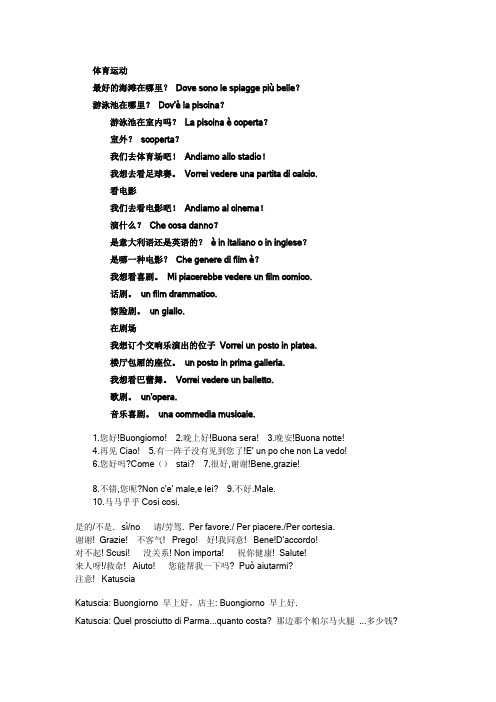
体育运动最好的海滩在哪里?Dove sono le spiagge più belle?游泳池在哪里?Dov'è la piscina?游泳池在室内吗?La piscina è coperta?室外?scoperta?我们去体育场吧!Andiamo allo stadio!我想去看足球赛。
Vorrei vedere una partita di calcio.看电影我们去看电影吧!Andiamo al cinema!演什么?Che cosa danno?是意大利语还是英语的?è in italiano o in inglese?是哪一种电影?Che genere di film è?我想看喜剧。
Mi piacerebbe vedere un film comico.话剧。
un film drammatico.惊险剧。
un giallo.在剧场我想订个交响乐演出的位子Vorrei un posto in platea.楼厅包厢的座位。
un posto in prima galleria.我想看巴蕾舞。
Vorrei vedere un balletto.歌剧。
un'opera.音乐喜剧。
una commedia musicale.1.您好!Buongiorno!2.晚上好!Buona sera!3.晚安!Buona notte!4.再见Ciao!5.有一阵子没有见到您了!E’ un po che non La vedo!6.您好吗?Come()stai?7.很好,谢谢!Bene,grazie!8.不错,您呢?Non c’e’ male,e lei? 9.不好.Male.10.马马乎乎Cosi cosi.是的/不是. sì/no 请/劳驾. Per favore./ Per piacere./Per cortesia.谢谢! Grazie! 不客气! Prego! 好!我同意! Bene!D'accordo!对不起! Scusi! 没关系! Non importa! 祝你健康! Salute!来人呀!/救命! Aiuto! 您能帮我一下吗? Può aiutarmi?注意! KatusciaKatuscia: Buongiorno 早上好。
2024年成人高考成考(高起本)英语试题与参考答案

2024年成人高考成考英语(高起本)模拟试题与参考答案一、语音知识(本大题有5小题,每小题2分,共10分)1、Listen to the following words and choose the one whose underlined part is pronounced differently from the others:A. dropB. sportC. workD. wordAnswer: CExplanation: In this option, the underlined part is pronounced /ɜːr/, while in the other options, it is pronounced /ɔː/ or /ɑː/ depending on the context.2、Choose the word whose underlined part has a different pronunciation from the others:A. withB. thickC. richD. witherAnswer: DExplanation: The underlined part in “thick” and “rich” is pronounced /ɪ/, while in “with” and “wither,” it is pronounced /ɪ/. The difference lies in the “th” in “wither,” which changes the pronunciation to /iː/.3、Listen to the following sentences and choose the word that is pronounced differently from the rest:A. catB. canC. carD. cartAnswer: B (can)Explanation: The other words are all pronounced with the “k” sound at the beginning. The word “can” has the “k” sound before the “an” vowel combination, but it’s not pronounced as a separate “k” sound.4、Choose the sentence that contains an example of the schwa sound:A. She has a cat.B. It is a small cat.C. The cat is beautiful.D. With a cat in the room.Answer: B (It is a small cat)Explanation: The schwa sound is represented by the symbol əand is a weak vowel sound. In option B, the word “is” is pronounced with a schwa sound, which is characteristic of the schwa. The other sentences don’t contain an example ofthe schwa sound.5、Listen to the following sentence and choose the word that is pronounced differently from the others.A. appleB. bananaC. catD. fatherAnswer: CExplanation: The words “apple,” “banana,” and “father” are all pronounced with a short /æ/ sound. The word “cat,” however, is pronounced with a long /æ/ sound. Therefore, “cat” is the word that is pronounced differently.二、词汇与语法知识(本大题有15小题,每小题2分,共30分)1、The conference will be held in the auditorium____all the sports stars are expected to attend.A. whereB. whichC. thatD. asAnswer: A. whereExplanation: “Where” is used here as a relative adverb to introduce a non-restrictive relative clause. In this context, “where all the sports starsare expected to attend” describes the location of the auditorium. The use of “which” or “that” would make the clause restrictive, which is not requiredin this sentence.2、Despite the heavy rain, the workers___on time for the site meeting.A. had comeB. comeC. cameD. were comingAnswer: C. cameExplanation: “Came” is the past tense of the verb “to come,” fitting the past tense context of the sentence. “Had come” and “were coming” suggesta past perfect and continuous aspect, which is not required in this context. “Come” is th e simple present tense, which does not match the past tense indicator in the beginning of the sentence.3、Choose the word that does not belong in the following list:a)translate b) eventual c) elect d) renovateAnswer: c) electExplanation: The word “elect” is the odd one out because it means “choose” or “select,” whereas the other words are all related to the process of changing or transferring something. “Translate” means to convert words from one language to another, “eventual” refers to an outcome that wi ll happen eventually, and “renovate” means to repair, update, or improve something.4、Choose the correct past participle form of the verb in parentheses:The students__________(visit) the museum on the weekend.a)visited b) has visited c) having visited d) will visitAnswer: a) visitedExplanation: The correct past participle to use with the modal verb “have” and the past tense of the verb “visit” is “visited.” Therefore, the correct sentence is “The students visited the museum on the weekend.” Options b) and d) are incorrect because “has visited” is the present perfect tense and “will visit” is the future simple tense. Option c) “having visited” is incorrect as it seems to suggest an ongoing action, while the sentence is about a completed action.5、Choose the correct word to complete the sentence:The speaker was___________by the audience, who cheered and applauded enthusiastically.A)ignoredB)admiredC)appreciatedD)overwhelmedAnswer: D) overwhelmedExplanation: The context of the sentence suggests that the speaker was positively affected by the audience’s reaction. “Overwhelmed” means to be affected emotionally in a very strong way, often with feelings of excitement or happiness. The other options do not fit the context as well: “ignored” means not paid attention to, “admired” means regarded with respect or approval, and“appreciated” means to be grateful for or to recognize the value of something.6、Complete the sentence with the correct form of the verb in parentheses: Although the weather was terrible, the marathon runners___________(be) determined to finish the race.A)areB)wereC)isD)were beingAnswer: B) wereExplanation: The sentence describes an action that happened in the past. The phrase “Although the weather was terrible” sets the scene, and the main clause “the marathon runners” is referring to people who were running in the past. Therefore, the correct form of the verb to use is the past simple tense, “were.” The other options are incorrect because “are” is the present simple tense, “is” is the singular present tense, and “were being” is the past continuous tense, which does not fit the context of the sentence.7、He was told not to go abroad. As a result, he .A) has decided to stayB) decided to stayC) will decide to stayD) decides to stayAnswer: B解析:本题考查时态。
参考罗伯特斯特恩的现代古典主义
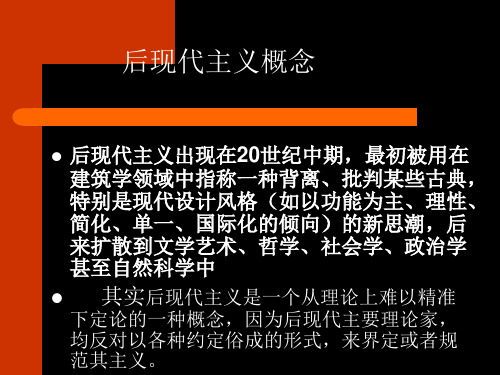
古根海姆博物馆的外部非常朴实无华,只是将博物馆的名字装饰了一下。平滑 的白色混凝土覆盖在墙上,使它们仿佛更像一座巨大的雕塑而不是建筑物。
建筑物的外部向上、向外螺旋上升,内部的曲线和斜坡则通到6层
螺旋的中部形成一个敞开的空间,从 玻璃圆层顶采光。美术馆分成两个体 积,大的一个是陈列厅,6层;小的 是行政办公部分,4层。陈列大厅是 一个倒立的螺旋形空间,高约30米, 大厅顶部是一个花瓣形的玻璃顶,四 周是盘旋而上的层层挑台,地面以 3 %的坡度缓慢上升。参观时观众先乘 电梯到最上层,然后顺坡而下,参观 路线共长430米。美术馆的陈列品就 沿着坡道的墙壁悬挂着,观众边走边 欣赏,不知不觉之中就走完了6层高 的坡道,看完了展品,这显然比那种 常规的一间套一间的展览室要有趣和 轻松得多。
1977年,美国建筑评论家詹克斯出版了一本书,书名是《后现 代主义建筑语言》。在这本书中,詹克斯宣称“现代主义建筑死 了”。他说得有鼻子有眼:“现代建筑于1972年7月15日下午3 时32分在美国密苏里州圣路易斯城死去。” 正是因为这段阴阳怪气的评述,一时之间,现代主义建筑死 亡说甚嚣尘上。而“后现代主义建筑”这一新的旗号,也从此在 历史舞台上拉开。当然,真正为后现代主义建筑打造理论的是罗 伯特·文丘里。文丘里在1980年的一次谈话里说:“就某种意义 而言,我想我们自己是现代主义的一部分,是从中发展出来的一 部分。”
参考罗伯特·斯特恩的《现代古典主义》分类简
介
1.“戏谑的古典主义”(Ironic Classicism)或译为“嘲讽的古典主 义”。也有人称为“符号性古典主义”或“语义性古典主义”。 是后现代主义中影响最大的一种类型,主要的后现代主义大师都 在这个范围内。
使用部分的古典主义建筑的形式和符号是其基本特征,而表现手 法却具有折衷的、戏谑的、嘲讽的特点。从设计的装饰动机来看, 应该说这种风格与文艺复兴时期以来的人文主义有密切联系。与 传统的人文主义风格不同在于嘲讽古典主义,或者狭义后现代主 义建筑设计明确地通过设计表现现代主义和装饰主义之间的无可 奈何的分离,而设计师除了冷嘲热讽地采用古典符号来传达某种 人文主义地信息之外,对于现代主义、国际主义风格基本是无能 为力的。因而充满了愤世嫉俗的冷嘲热讽、调侃、游戏、玩笑色 彩。
重塑场所_马里奥_博塔的宗教建筑评析

Sartirana Italy 187/1995) 初读博塔会觉得他的手法很容易识别,他天生
善用几何原型 , 因此也很容易抄袭 但如果超越了 这个层面 人们将会在博塔的方案中清楚的发现他 立足于分析的刻苦探索精神 严谨的几何构成原则 和室内空间的塑造紧紧地联系在一起 这种关系在 圣彼得教堂中得到清晰地诠释 严谨的平面构成一 个基点 和相邻的古老小村的中心形成对话关系 平面的几何性源于两个规则体块的互相穿插 而外 部立方体和内部圆柱之间则形成了经深思熟虑以后 创造的空间效果 这种几何形同时也是一种对力量 的诠释以及对不可企及的完美要求的拒绝 巨大的 门廊标志出经由两个侧面梯段所到达的入口位置 内部 圆柱在立方体中升起 两者之间形成一个供 小村妇女使用的两层高的画廊 整个教堂的外墙是 封闭的 自然光只能通过沿立方体顶部外圈布置的 天窗射入 光线沿墙倾泻下来 将美丽的红砖和墙 体细腻的质感展现在人们的面前 建筑师格外精确 地设置了光影的角度 以达到最佳的视觉和空间效 果以及建筑功能性和精神性的统一
博塔通过这5个蕴涵古老传统意味的中小型教 堂的设计 充分体现了宗教建筑的地位 为这种日 渐式微的建筑类型重新注入生命活力 由于博塔非 凡的创造力 5 个教堂各异其趣 但人们仍可清楚 地感受到一种严格忠于一贯理念的精神 这种理念 不仅源于罗马风 也源于从古至今的建筑类型 在 这里 博塔运用他始终强调的 建筑应该 重塑场 所 的原则 无论是地处闹市的奥德利柯小教堂 艾 弗利大教堂或是小村中的圣彼得小教堂还是几乎与 世隔绝的新蒙哥诺教堂和塔玛诺山顶教堂 都对场 所进行了空间 环境 文化等方面的积极改造 创 造出一个供人祈祷 回忆 冥想的纯净的内部空间
